Mkwiru I. H., Pima N. E., Byakugila N., Solomon P.
Tanzania Forestry Research Institute (TAFORI), Kibaha, Tanzania
Correspondence to: Pima N. E., Tanzania Forestry Research Institute (TAFORI), Kibaha, Tanzania.
| Email: |  |
Copyright © 2016 Scientific & Academic Publishing. All Rights Reserved.
This work is licensed under the Creative Commons Attribution International License (CC BY).
http://creativecommons.org/licenses/by/4.0/

Abstract
This study was conducted to analyse product chain analysis of the mostly exploited timber tree species from Ruvu North Forest Reserve (RNFR) in Pwani Region. A total of 43 mostly over exploited timber tree species identified were used for timber, poles and charcoal production. Albizia petersiana, Dalbergia melanoxylon, Dichrostacys cinerea and Diopyros consulatae were the main tree species identified. Fabaceae family dominates the mostly overexploited timber tree species followed by Combretaceae, Euphorbiaceae and Meliaceae. Illegal timber harvesting, poles and charcoal trading; poor management, transpotation and processing were the main factors contributing to over exploitation of the timber species from the Ruvu North Forest Reserve. There is a need to consider planting indigenous tree species especially mostly over exploited timber tree species identified in the reforestation and afforestation programmes.
Keywords:
Timber tree species, Ruvu North Forest Reserve, Tanzania
Cite this paper: Mkwiru I. H., Pima N. E., Byakugila N., Solomon P., Product Chain Analysis of the Mostly over Exploited Timber Tree Species in the Ruvu North Forest Reserve, Tanzania, International Journal of Agriculture and Forestry, Vol. 6 No. 3, 2016, pp. 115-122. doi: 10.5923/j.ijaf.20160603.03.
1. Introduction
Forests and forests products harvesting in East African forests have gone uncontrolled for ages and have resulted into poorly stocked forests. The higher dependence of poorer people on natural resources, especially forest products, and the evident over utilization of natural resources that is leading to environmental degradation and increased poverty, highlights the need to ensure environmental concerns are acknowledged within the other sectoral policy [1]. Whilst forestry is not amongst priority sector for poverty eradication in Tanzania, the sustainable conservation of forests and woodlands is a prerequisite for the development of the priority sectors, namely education, health, agriculture, roads, water, and judiciary [2]. Indeed, forests and woodlands, covering over a third of the land area, are the most valuable natural resources in Tanzania, supporting rural and urban livelihoods through the provision of essential products, commercial services and many others, generally undervalued, environmental services [1]. The [3] further recognizes that the trade in wood and non wood forest products offer considerable potential for increased economic development through income and employment generation as well as export earnings [3]. The policy also states unregulated trade can instigate uncontrolled exploitation and has the potential of accelerating forest destruction and degradation through loss of biodiversity. Trade in forest products, particular for timber and charcoal, has contributed to the degradation of Miombo woodlands and coastal forests that covers two third of the country [3].The Ruvu North Forest Reserve (RNFR) is one of the natural forests in Tanzania which is under Participatory Forest Management (PFM). The forest has high biodiversity values including climate regulation, ecosystem services and species habitat [4]. It provides fuel wood to millions of the people living in Dar es Salaam and Pwani regions [5]. However, the forest is threatened by deforestation resulting from high demands for timber, poles, charcoal and firewood. Therefore, efforts are needed to conserve this forest. The aim of this study was to analyse product chains of the mostly exploited timber species from Ruvu North Forest Reserve. The analysis of the chain of these important timber species provide a clue information on the forests management in regard to timber harvesting, trading, processing and utilization of the products. These issues are key to the improvement of forests management and ensuring the quality of the services offered by the forest service.
2. Material and Methods
Study area descriptionThis study was conducted at Ruvu North Forest Reserve located at latitude 6°33’- 6°43’ S and longitude 38°48’- 39°03’ E at 80 m a.s.l. It is one of the Forest Reserves found in the Pwani region in the Eastern part of Tanzania. The area has average rainfall of 900 mm falling in two seasons (long rains between March and May and short rains between November and December) with temperatures ranging between 18 – 33°C [6]. Ruvu North Forest Reserve which covers 67,000 ha (North Ruvu, 32 000 ha; and South Ruvu, 35 000 ha.) was established in 1957 is under Tanzania Forest Services (TFS). About 10% of this forest has been demarcated for JFM approach whereby the stakeholder villagers are allocated forest management plots (PFM) at household level. Sampling DesignPurposive sampling was adopted to select three villages namely Yombo, Kerege and Kiegea village surrounding RNFR. Simple random sampling was employed to collect data on timber, charcoal, poles and firewood transporters. 20 respondents were interviewed from each village, 10 transporters using trucks/lorries and 10 transporters using bicycles and motor bicycles were also interviewed.Data collection MethodsHousehold questionnaire survey, focus group discussion and participant observation were used in data collection. Both closed and open-ended questionnaires were used to interview heads of households and key informants in order to gather various information’s in relation to the study. In closed ended questionnaires, a number of alternative answers were provided while in the open ended questionnaires respondents were free to give their own answer views. Data collected based on respondents perceptions regarding market prices and trading procedures for timber, charcoal, firewood and poles. In Focus group discussion whereby a group of 6–10 respondents of which men and women were incorporated was done. The meeting addressed general information on household characteristics, market prices and trading procedures for timber, charcoal, firewood and poles. A checklist was used to guide the discussion which was undertaken with key informants including village leaders and elders. Direct researcher observation was made on the selected household to observe general situation on the management, harvesting, market prices and transpotation of the timber species for charcoal, firewood, timber and poles existing in the area. Dar es Salaam city, Bagamoyo, Kibaha and Mlandizi towns which are the destination of the illegally harvested timber from the Ruvu North Forest Reserve were visited to collect data in relation to the study. In each studied area, 15 timber yards, poles collection centres, charcoal selling points and furniture centres were visited and the information regarding market prices and trading procedures for charcoal, firewood and poles were collected.
3. Data Analysis
Both qualitative and quantitative information’s were analysed using Statistical Package for Social Science computer software tools. Qualitative information’s collected through verbal discussion and open ended questionnaires were broken down into smaller meaningful themes and analysed to bring statistical meaning. Data were explored for distribution of responses and central tendency (means, percentage and frequencies). Cross tabulations was carried out to compare Qualitative data obtained during PRA was analyzed in collaboration with the communities and the findings were used along with the quantitative data to triangulate and enrich data collected by other methods. In addition, content and structural–functional analyses were used to analyzed qualitative data collected through focus group discussions, key informant’s interviews and direct observation. Timber chain analysis indicator value matrix as assessment tool that asseses the chains of the timber species for charcoal, firewood, timber, and poles in four main aspects which are management, harvesting, transportation and consumptions was used in the analysis. In each aspect, there are indicator factors which are assigned values based on light and number values. The numbers ranged from one to three. One which is also a green colour indicates that the conditions are food for that species at that particular aspect. Two which is also a yellow colour means that conditions are neither good nor bad but need improvement for the species at a particular aspect. Three which is red colour means that conditions for a species at a particular point are not good and thus urgent measures are needed for improvement.
4. Results
Over exploited timber tree species identified in the Ruvu North Forest ReserveA total of 11 tree species from 8 families were identified as timber tree species in the study area (Table 1). 12 tree species from 7 families were identified as mostly over exploited timber tree species used for poles (Table 2) while 20 trees species were identified as timber tree species for charcoal production representing 11 families (Table 3). The Fabaceae family dominates the mostly overexploited timber tree species of the RNFR of all counted individual timber species. The other dominant families based on number of counts included; Combretaceae, Euphorbiaceae and Meliaceae (Table 1, 2 and 3). The mostly exploited tree species identified are also important for firewood collection. Results show that, the dominant timber tree species from RNFR have been over harvested for various uses such that very few species remaining in the forest. Table 1. List of the mostly exploited timber tree species from the Ruvu North Forest Reserve
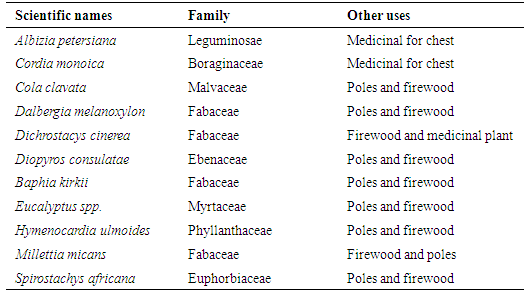 |
| |
|
Table 2. List of the mostly exploited tree species for poles from the Ruvu North Forest Reserve
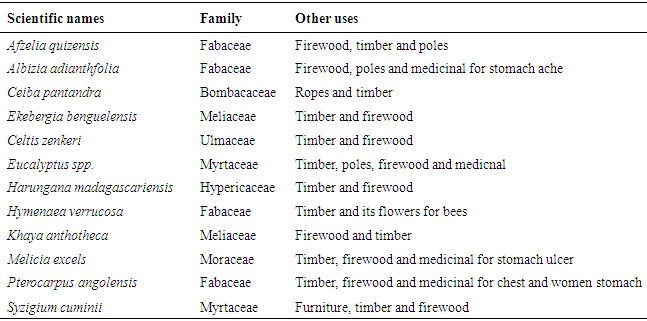 |
| |
|
Table 3. List of the mostly exploited tree species for charcoal from the Ruvu North Forest Reserve
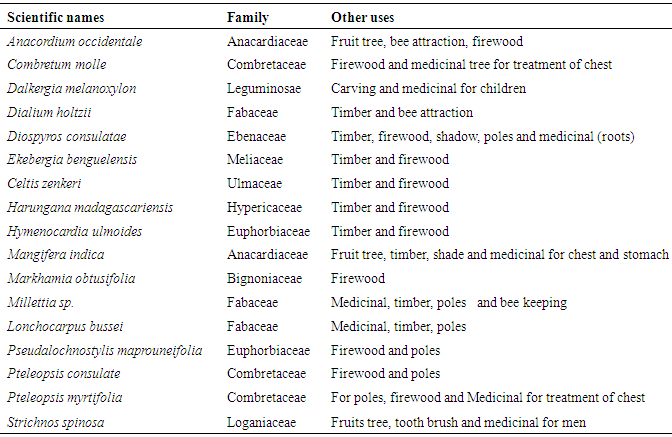 |
| |
|
Factors contributing to over exploitation of the timber tree species from Ruvu North Forest Reserve Management issuesForty percent of the respondents stated lack of financial resources is the most contributing factor for over exploitation of timber tree species from RNFR (Figure 1). Findings revealed that, there are inadequate financial resources as well as necessary equipments to deal with the illegal harvesting of timber tree species from the forest. While 25% of the respondents mentioned about lack of alternative energy sources as a contributing factor for over exploitation of timber species for charcoal and firewood. Twenty percent (20%) of the respondents mentioned about lack of alternative income generating activities as a contributing factor for over exploitation of timber species from the RNFR. Thus communities have to depend on harvesting and selling of charcoal, poles, firewood and timber from the forest to earn their living. However, about 10% of the respondents among surveyed villages mentioned weak enforcement leading to over exploitation of timber species from RNFR. Respondents included issues of harvesting licenses such as extension time for licenses, errors in issuing Transit Passes (TP) and validity of the harvesting license and the TP. Nevertheless, 5% of the respondents suggested that there is a high demand of the timber species from RNFR in the nearby towns and cities for various uses. Respondents admit that the demands are high in Dar es Salaam city, Kibaha, Mlandizi and Bagamoyo towns and thus contributing to over exploitation of timbers species from Ruvu North Forest.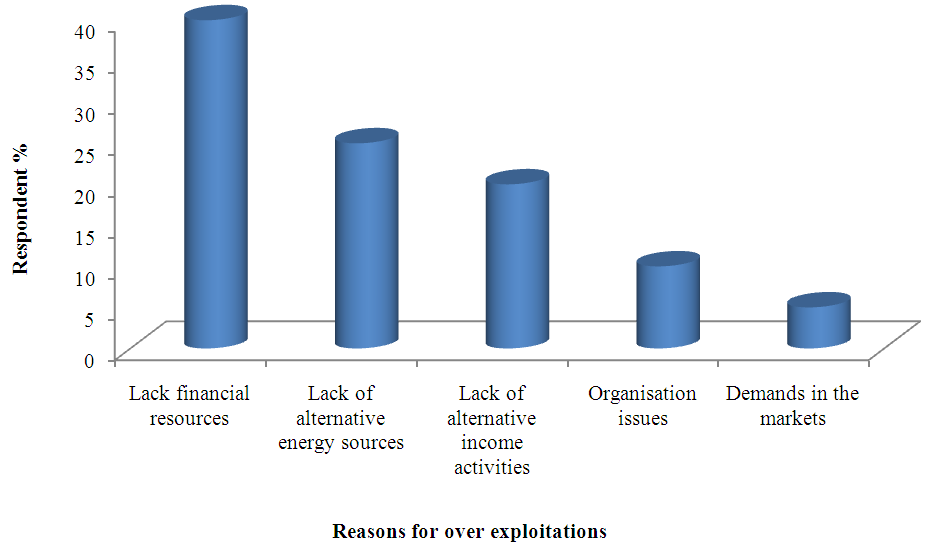 | Figure 1. Factors contributing to over exploitation of timber species from Ruvu North Forest Reserve |
Illegal harvesting Findings revealed a serious over exploitation of timber species for charcoal, firewood, poles and timber from RNFR. RNFR being a protected area, it is difficult to get the clear information on the quantity of the illegally harvested and transported timber species at the check points in the Coast region especially those near the RNFR. Rather the illegally transported timber and related products from RNFR is with a combination of illegally transported timber products from other forest reserves in Tanzania. Morogoro appered the leading region with over 40% of the illegally transported timber which is caught at the check points located outside the RNFR followed by Tanga region (30%), Dodoma (7%), Rukwa (6%), Singida (5%), Bukoba (5%), Iringa (4%) and Mbeya (3%) (Figure 2). | Figure 2. Regions with forest reserves which have illegally transported timber traced at the check points of the Ruvu North Forest Reserve |
Transportation issues Majority of the respondents (60%) admitted organisational and management issues are contributing to illegal transportation of timber from RNFR and other forests in Tanzania (Figure 3). This is linked with organisational problems in issuing of harvesting licences and transportation permits, lack of patrol equipments and poor law enactment against illegal transportation of timber. 20% of the repsondents pointed out that it is the mode of transportation which lead to the illegal transportation of the timber from RNFR such as transportation in the boxed containers and in the public transport which makes it difficult to deal with it. About 15% of the respondents mentioned that lack of alternative energy sources, corruption, lack of alternative income activities and demands of the timber and related products in the markets are the main factors explained by the respondents.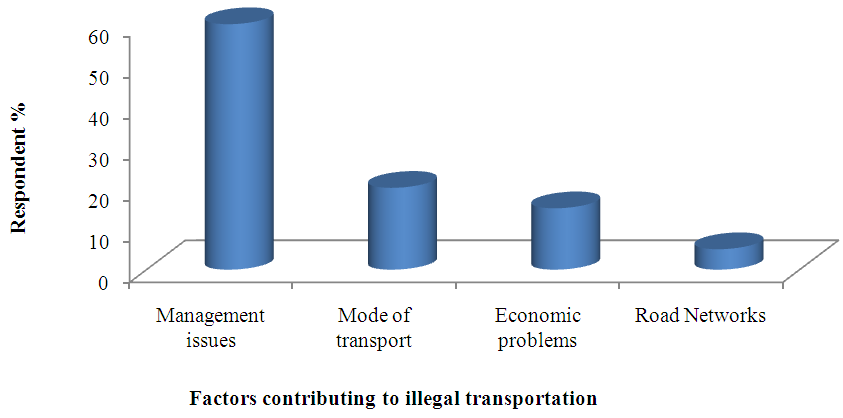 | Figure 3. Factors contributing to illegal transportation of timber from Ruvu North Forest Reserve |
Modes of transportation and their influence in over exploitation of timber tree speciesFindings show that the use of motor cycles popularly known as “bodaboda” has a high influence in over exploitation of timber species in and outside of the forest. There is a high ranking (8/10) for the use of motorcycle in the forest and 4/10 outside of the forest in transportation of charcoal, firewood, timber, firewood but with a limitation on the transportation of poles. The use of lorries is also a dominant mode of transportation especially outside the forest ranking 8/10 and low influence (2/10) in the forest. Bicycles are also used in the transportation of these forest products particularly from the forests (ranking 7/10) and 1.5/10 outside the forest (Figure 4). | Figure 4. Modes of Transportation of timber from Ruvu North Forest Reserve |
Quantity of timber products transported from the Ruvu North Forest ReserveLorries are commonly used to transport large amount of timber products from the forests. Seven tonne lorries carrying 100 to 120 sucks of charcoal. Those carrying timber could carry upto 1500 pieces. However, the exact amount/quantity of sawn timber to be carried by a 7 tonne lorry is subject to size and species of the particular timber. In terms of size, for example, 1``x8``x10ft of sawn timber constitutes 500 pieces to be carried and 2``x6``x10ft constitutes 350 to 400 pieces. It can also carry an average of 400 poles and 20m3 of firewood. A motor bicycle can carry an average of 3 sucks of charcoal from the forest, 24 pieces of timber, 10 to 20 poles and a bundle of firewood weighing up 100 kg. On the other hand, a bicycle can carry an average of 2 sucks of charcoal, 12 pieces of timber, 6 poles and a bundle of firewood weighing up to 50 kg. Table 4. Quantity of timber products transported from Ruvu North Forest Reserve
 |
| |
|
Consumption and Trading issues Main uses of the timber species from Ruvu North Forest ReserveMajority of the respondents (60%) stated that timber from the RNFR is mostly used as a source of energy for cooking (charcoal and firewood). 25% used for making furniture such as tables, beds, doors, windows and chairs and 10% used as building materials for constructions especially poles. While 5% of the respondents revealed that timber tree species over exploited for making of the coffins (Figure 5).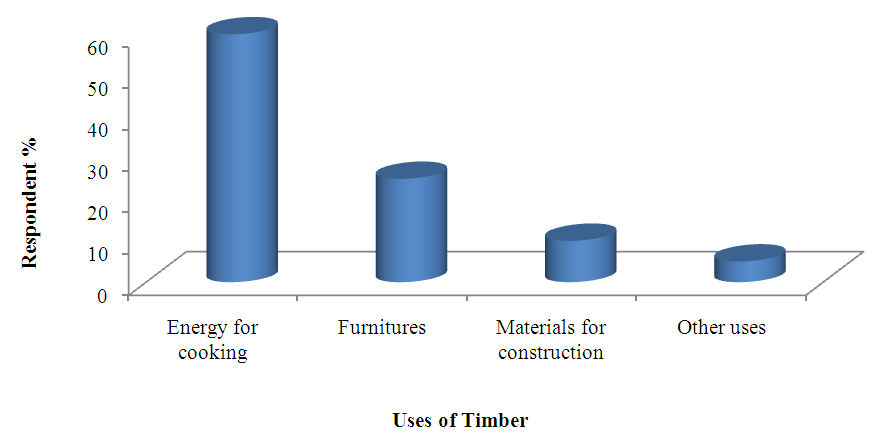 | Figure 5. Main uses of timber species from the Ruvu North Forest Reserve |
Factors influencing the price of timber species and their products in the marketsFindings revealed that quality of timber species, weather, demand/ availability and technological innovations has a much more influence on the price of timber and poles as compared to charcoal and firewood (Figure 6). Pterocarpus angolensis is the mostly expensive timber from RNFR sold in Dar es Salaam. General price goes up to TZS 45,000 due to its high quality. Weather has also an influence on the price of timber and charcoal. Table 5 shows the prices of products from timber tree species. Results revealed that the price of the suck of charcoal range 30,000 – 40,000 TZS but may go up to 60,000 TZS when it is a rainy season because of availability and transportation problems. Nevertheless, the price for some of the timber species is very high because of scarcity in the market as well as in the forest. Pterocarpus angolensis and Afzelia quizensis are the timber species with high scarcity thus making the prices very high in the markets. In addition, new technological innovations have the influence on the price of poles, timber, charcoal and firewood. Prices for poles in Dar es Salam city is said to have declined after the introduction of the iron poles for the construction of tall buildings. The introduction of the ready made furnitures from Asia and Europe such a tables, chairs and beds has an influence on the price of timber. Also, the incresing use of gas cooker for cooking has some effects on the price of charcoal.Table 5. Prices of the products of timber species from Ruvu North Forest Reserve
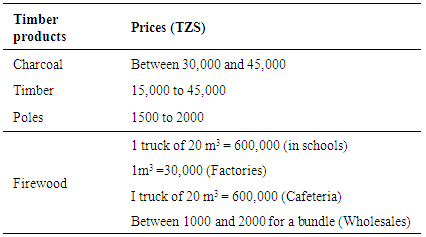 |
| |
|
 | Figure 6. Factors influencing the price of timber species from Ruvu North Forest Reserve |
5. Discussion
Over exploited tree species identified in the Ruvu North Forest ReserveThe Ruvu North Forest Reserve is one of the forest reserves in Tanzania with many biodiversity values including wood and wood products, food, fodder, medicine, shelter, employment, recreation and species habitats [4]. It also offers many climate regulation and above all provides fuel wood to run the lives of the millions of the people living in Dar es Salaam and Coast regions [5]. There is a high over exploitation of timber tree species for charcoal making because of the huge demand for charcoal in Dar es Salaam and Pwani regions. Most of timber tree species for poles are from the part of the forest which is designated for community management under PFM. A lesser extent of the harvested poles comes from inside the natural forest. Over exploitation of tree species for timber, charcoal, firewood, timber and poles results to deforestation of the RNFR. [6] pointed out that the forest is continuously affected by the deforestation process affecting the biodiversity value, scarcity of fuel wood and food crops due to the decline of rainfall.This study identified mostly exploited tree species from the RNFR. They are mainly exploited for the community demands for firewood, charcoal, poles and timber. To reduce the pressure for community dependence on this forest, the Ruvu North Forest Project ensured that there is a community participation in conservation of the forest by demarcating 900 ha part of the RNFR into 300 Forest Management Plots (FMPs) of three ha each which are managed by the households under custodianship of either male or female head. Each household started management and development of the FMPs by promoting regeneration of the forest resources (i.e. in situ conservation of valuable timber species such as Dalbergia melanoxylon and Afzelia quanzensis, and planting seeds/seedlings of fast forest growing exotic and indigenous species [7].Factors contributing to over exploitation of the timber species from the Ruvu North Forest ReserveIllegal harvesting, illegal trading and poor management of Ruvu North Forest Reserve negatively affect local forest-based livelihoods [8, 9, 10]. Efforts are needed to deal with the factors identified specifically illegal timber, poles and charcoal trade. Policy intervention to rescue the RNFR was through the introduction of the Participatory Forest Management by the government of Tanzania through the MNRT in collaboration with the government of Norway through the development Agency NORAD which established the project called the Ruvu Fuel wood Pilot Project [7]. Deforestation in the Coast region particularly in the RNFR is attributed by the community demands for charcoal, timber and poles. Other factors such as agricultural encroachment and fire contribute to deforestation in Tanzania [11]. According to [12] natural forests in Tanzania decreased by about 12.7% from 1980 to 1990 and the various sources put the rate of deforestation per year at about 300,000 - 400,000 ha per year. In addition, the illegally harvested timber from the RNFR is locally consumed in the nearby towns particularly Dar es Salam, Kibaha, Mlandizi and Bagamoyo. Timber pricing in these towns and in Tanzania in general is controlled by Tanzania Forest Service. The prices and royalties however attached to different forest products are not based on any scientific research. The prices for timber and non-timber forest products of Tanzania therefore remain the lowest in East Africa.
6. Conclusions
This study intended to analyse product chains of the mostly exploited timber species from Ruvu North Forest Reserve. A total of 11, 12 na 20 mostly over eploited timber tree species identified in the RNFR used for timber, poles and charcoal production respectively. Fabaceae family dominates the mostly overexploited timber tree species followed by family Combretaceae, Euphorbiaceae and Meliaceae. Illegal harvesting, illegal timber, poles and charcoal trading and poor management were the factors contributing to over exploitation of the timber species from the RNFR. Efforts are needed to deal with the factors identified specifically illegal timber, poles and charcoal trade. The study manifest the important of the RNFR to the livelihood of the communities living es Salaam and nearby towns. Based on the factors identified to contribute to over exploitation of the timber species, there is a need to consider planting the indigenous tree species especially mostly overexploited timber tree species identified in the reforestation and afforestation programmes around the RNFR. There should be increasing an effective protection of the RNFR through law enactment on the transportation and harvesting of the timber products.
ACKNOWLEDGEMENTS
We acknowledge Tanzania Forest Fund for financing this study.
References
| [1] | Milledge, S.A.H. and Kaale, B.K. 2005. Linking trade with infrastructural development in southern Tanzania, basiline data before completion of Mkapa bledge. Pg 8 -34. |
| [2] | Kilahama, F. 2002. Natural Resources for Sustainable Development: A Case for Poverty Reduction in Dar es Salaam, Tanzania. Kakakuona 25: 26 – 42. |
| [3] | National Forest Policy. 1998. Ministry of Natural Resources and Tourism. Government Printers, Dar es Salaam, United Republic of Tanzania. |
| [4] | MNRT, 2001. National Forest Programe in Tanzania. 2001- 2010. FBD, Dar es Salaam pp?. |
| [5] | Mndolwa, M.A. 1999. Human Impact on Woody Vegetation in Ruvu North Forest. Tanzania. A dissertation submitted in partial fulfilment for the degree of Master of Science at the Sokoine University of Agriculture. Morogoro 85 pp. |
| [6] | Msuya, T., Mndolwa, M. and Hamza, K. 2004. Potential role of Ruvu Fuel wood pilot project in Forest Conservation and reducing energy crisis in Dar es Salaam city and nearby towns. Paper presented at the Annual General Meeting of Tanzania Association of Foresters held at Morogoro Hotel from 28 – 29 October 2004. |
| [7] | Mndolwa, M. and Msuya, T. 1999. Survey of acceptability of agroforestry technology as applied in Ruvu Fuel wood pilot project and its impact in afforestation of Ruvu Forest Reserve. |
| [8] | Brosius, P. 1997. Prior Transcript, Divergent Path: Resistance and Acquiesence to Logging in Sarawak, East Malaysia. Comparative Studies in Society and History, 39 (3), 468 – 510. |
| [9] | Maruyama, M., Marioka, N. 1998. The Impact of deforestation in Brazilian Amazonia: The indigenous people of Randonia State. Journal of Forest Planting, 4 (2), 71 -75. |
| [10] | Poore, D. 1986. The vanishing forces: The human consequences of deforestation. London, UK: Zed. 132p. |
| [11] | Burgess, N.D., Abdallah, J., Lukumbuzya, K., Urock, J., Malugu, I., Sumbi, P., Kijazi, A., Milledge, S., Schaafsma, M. and Makala, J. 2013. Trends in the production of charcoal and timber from Tanzania’s coastal forests. The Arc Journal Issue 28: 25 – 29. |
| [12] | FAO 1993. Forest Resource Assessment 1990. Tropical Countries. Rome: United Nations Food and Agriculture Organization. Rome Italy. www.fao.org/docrep/007/t0830e/t0830e0.htm. |









 Abstract
Abstract Reference
Reference Full-Text PDF
Full-Text PDF Full-text HTML
Full-text HTML



